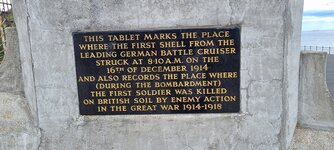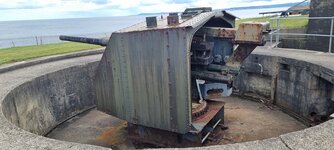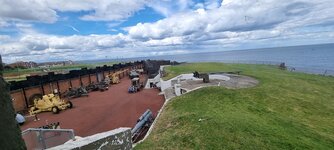For those outside the region, it may surprise you to learn that Hartlepool is home to the only First World War battle site in the United Kingdom. The Heugh Battery Museum, situated in the town's Headland, is dedicated to remembering the Hartlepool Bombardment of 1914 and sharing passion for local history.
The small, independent heritage site is packed with artefacts that help tell the story of the wartime life in the area and beyond. Yet, in 2019 it was nearly lost forever, only surviving through a remarkable grassroots fundraising in the local community. Here, Teesside University student and Heritage Unlocked intern Adam Shillaw explores the history of the museum and reveals a story of survival against the backdrop of a challenging time for the heritage sector…
Opened in 2008 after a successful fundraiser the Museum is sited on the Heugh Battery on the North East Coast, which famously saw action on the 16th December 1914 when the German Navy bombarded Hartlepool. For roughly 40 minutes the town was bombarded with over 1000 shells fired. Part of a three town bombardment alongside Scarborough and Whitby, the shipbuilding town of Hartlepool suffered the most, with 137 killed and far more injured. The German ships fired from close range meant that shells literally bounced throughout the town, hitting industrial targets and civilian homes alike. Photographs of the aftermath in the collections
of Hartlepool Borough Council reveal the devastating aftermath, whilst personal accounts describe harrowing scenes of bombs falling like thunder as people evacuated from the incoming fire. Contemporary methods of remembrance can be seen through the work of local researcher and artist Ian Lightfoot. Ian has created an amazing art piece for the museum, depicting the raids centenary he attended in 2014 to honour those that were lost, enriching local heritage. He hopes it will stand in the museum one day, when they have space for it.
The main targets of the raid were the industrial areas of the town. Notably the shipyards and gasworks with the additional goal of spreading fear throughout the civilian population. The Heugh Battery, being a functioning coastal battery which, including the neighbouring Lighthouse Battery (long since dismantled) held three BL 6-inch Mark VII guns against battlecruisers Seydlitz, Moltke
and Blücher. Although the First World War had started several months before, this was the first time British civilians had come under fire and the site was the scene of the first death of the raid. Private Theophilus Jones, 29, the first soldier killed on home soil by enemy action in close to 200 years, is memorialised with a tablet near to the Museum site.
Community spirit sharing Hartlepool’s story
A sense of community is very much evident at the museum, with manager Diane, Museum Assistants Andy and Briannna and tea room assistants Carole and Michelle working alongside volunteers who fulfil roles as tour guides, working in the armoury, maintaining the museum’s exhibits and helping in the tea rooms.
The outdoor seating area at the museum’s tea rooms also serves as a reminder of the voluntary spirit, with one of the huts featuring a crocheted wall drape of poppies, made by the Heugh Yarners, a community group of “yarn guerrillas” which adds to the community feeling the Heugh was built on. All of the huts have either work by the Heugh Yarners on display or from local school pupils.
The venue is also dog friendly with tea room assistant Carole revealing that “we welcome them, they can actually come in on site, we are very dog friendly”. Many dogs even drag their owners into the tea rooms to check it out with one neighbour's dog coming by every morning. With good reason too as the tea rooms have both a dog ice cream and “puppuccino” that are both very popular.
For military and local history enthusiasts, the museum’s tour guides are a highlight. Tour guide Evie guides visitors around the site and provides fascinating insights into some of the personal stories revealed in the museum: There is a copy of the newspapers printed names of all the deaths. Sometimes, we take people there to look down the names and they often find a relative. It is
sometimes quite moving when they find one of their family members.
Evie’s passion for the personal stories is inspiring, with Manager Diane’s encouragement for guides to follow their passion helping create a knowledgeable and engaging experience, whilst those visitors who prefer are also free to explore the site themselves.
Amongst the highlights are the battery foundations, a selection of guns, a Chieftain tank and a number of vehicles along with military ephemera, a trench exhibit and an Anderson shelter to transport visitors back in time.
Challenges for the coast museum.
Today, the future is still uncertain, as, Museum Manager Diane Stephens reveals, there is lots of work to do to ensure the museum’s long-term survival: I don’t think any museum big or small can rest on its laurels. We always have to work very hard to secure our ongoing survival and it doesn’t take much to knock you out of the water.
The Heugh Battery Museum receives no core financial assistance from local authorities. The museum is largely reliant on both donations and sales from the tea rooms and gift shop. The Museum also places emphasis on affordability and keeping history accessible. Something that both the COVID pandemic and ongoing cost of living crisis have put to the test.
The Heugh Battery Museum owes its survival to the grassroots community action and spirit amongst locals with pride in their heritage, with Andy Stephens from the museum reflecting “In 1999 this place was 6 weeks away from becoming a carpark”. Such a fate was avoided with Key Military, an online portal for their British military magazines describing a successful fundraising
effort and a trust being founded to manage the site by local people.
Running a volunteer-led museum brings lots of challenges but the Heugh Battery Museum’s location on the Headland brings further considerations. Having recently applied for a large grant to survey the extent of damage to the site including issues such as rust and concrete decay caused by the proximity to the North Sea, although this is all par for the course for the venue.
The COVID-19 pandemic brought unprecedented pressures and the ongoing cost of living crisis poses challenges for the heritage sector, but conversely offers locals and visitors from elsewhere the opportunity for a low-cost day out with a Pay What You Decide entry fee.
Fundraising and capacity
The question of funding during these difficult times is of course prevalent, and the challenges of capacity and match-funding poses a potential barrier for museums. Yet, as the 2019 fundraising shows, where a 16 mile Tommy 2 Tommy walk from Seaham to the museum raised over £23,000 and Swedish metal band Sabaton also raised over £4,000 in donations with a limited t-shirt sale. Over £30,000 was raised overall. The volunteers, local community and donors from outside the area rallied around to help ensure the survival of the Museum. As Diane reveals: In 2019 is when we put out the call because we were literally about to close the doors and that’s when the whole community got together... People have given money via an online fundraiser. So that was a close the door time and people rallied and refused to let it shut down.
The Heugh Battery Museum lives and dies by the goodwill and generosity of its visitors and community. This emphasis on the community is a major part of its identity as well as the events it remembers. The sense of history the museum gives off cannot be adequately put into words. It really should be visited to experience it first-hand and to help preserve the only WW1 battle site
in the UK.




The small, independent heritage site is packed with artefacts that help tell the story of the wartime life in the area and beyond. Yet, in 2019 it was nearly lost forever, only surviving through a remarkable grassroots fundraising in the local community. Here, Teesside University student and Heritage Unlocked intern Adam Shillaw explores the history of the museum and reveals a story of survival against the backdrop of a challenging time for the heritage sector…
Opened in 2008 after a successful fundraiser the Museum is sited on the Heugh Battery on the North East Coast, which famously saw action on the 16th December 1914 when the German Navy bombarded Hartlepool. For roughly 40 minutes the town was bombarded with over 1000 shells fired. Part of a three town bombardment alongside Scarborough and Whitby, the shipbuilding town of Hartlepool suffered the most, with 137 killed and far more injured. The German ships fired from close range meant that shells literally bounced throughout the town, hitting industrial targets and civilian homes alike. Photographs of the aftermath in the collections
of Hartlepool Borough Council reveal the devastating aftermath, whilst personal accounts describe harrowing scenes of bombs falling like thunder as people evacuated from the incoming fire. Contemporary methods of remembrance can be seen through the work of local researcher and artist Ian Lightfoot. Ian has created an amazing art piece for the museum, depicting the raids centenary he attended in 2014 to honour those that were lost, enriching local heritage. He hopes it will stand in the museum one day, when they have space for it.
The main targets of the raid were the industrial areas of the town. Notably the shipyards and gasworks with the additional goal of spreading fear throughout the civilian population. The Heugh Battery, being a functioning coastal battery which, including the neighbouring Lighthouse Battery (long since dismantled) held three BL 6-inch Mark VII guns against battlecruisers Seydlitz, Moltke
and Blücher. Although the First World War had started several months before, this was the first time British civilians had come under fire and the site was the scene of the first death of the raid. Private Theophilus Jones, 29, the first soldier killed on home soil by enemy action in close to 200 years, is memorialised with a tablet near to the Museum site.
Community spirit sharing Hartlepool’s story
A sense of community is very much evident at the museum, with manager Diane, Museum Assistants Andy and Briannna and tea room assistants Carole and Michelle working alongside volunteers who fulfil roles as tour guides, working in the armoury, maintaining the museum’s exhibits and helping in the tea rooms.
The outdoor seating area at the museum’s tea rooms also serves as a reminder of the voluntary spirit, with one of the huts featuring a crocheted wall drape of poppies, made by the Heugh Yarners, a community group of “yarn guerrillas” which adds to the community feeling the Heugh was built on. All of the huts have either work by the Heugh Yarners on display or from local school pupils.
The venue is also dog friendly with tea room assistant Carole revealing that “we welcome them, they can actually come in on site, we are very dog friendly”. Many dogs even drag their owners into the tea rooms to check it out with one neighbour's dog coming by every morning. With good reason too as the tea rooms have both a dog ice cream and “puppuccino” that are both very popular.
For military and local history enthusiasts, the museum’s tour guides are a highlight. Tour guide Evie guides visitors around the site and provides fascinating insights into some of the personal stories revealed in the museum: There is a copy of the newspapers printed names of all the deaths. Sometimes, we take people there to look down the names and they often find a relative. It is
sometimes quite moving when they find one of their family members.
Evie’s passion for the personal stories is inspiring, with Manager Diane’s encouragement for guides to follow their passion helping create a knowledgeable and engaging experience, whilst those visitors who prefer are also free to explore the site themselves.
Amongst the highlights are the battery foundations, a selection of guns, a Chieftain tank and a number of vehicles along with military ephemera, a trench exhibit and an Anderson shelter to transport visitors back in time.
Challenges for the coast museum.
Today, the future is still uncertain, as, Museum Manager Diane Stephens reveals, there is lots of work to do to ensure the museum’s long-term survival: I don’t think any museum big or small can rest on its laurels. We always have to work very hard to secure our ongoing survival and it doesn’t take much to knock you out of the water.
The Heugh Battery Museum receives no core financial assistance from local authorities. The museum is largely reliant on both donations and sales from the tea rooms and gift shop. The Museum also places emphasis on affordability and keeping history accessible. Something that both the COVID pandemic and ongoing cost of living crisis have put to the test.
The Heugh Battery Museum owes its survival to the grassroots community action and spirit amongst locals with pride in their heritage, with Andy Stephens from the museum reflecting “In 1999 this place was 6 weeks away from becoming a carpark”. Such a fate was avoided with Key Military, an online portal for their British military magazines describing a successful fundraising
effort and a trust being founded to manage the site by local people.
Running a volunteer-led museum brings lots of challenges but the Heugh Battery Museum’s location on the Headland brings further considerations. Having recently applied for a large grant to survey the extent of damage to the site including issues such as rust and concrete decay caused by the proximity to the North Sea, although this is all par for the course for the venue.
The COVID-19 pandemic brought unprecedented pressures and the ongoing cost of living crisis poses challenges for the heritage sector, but conversely offers locals and visitors from elsewhere the opportunity for a low-cost day out with a Pay What You Decide entry fee.
Fundraising and capacity
The question of funding during these difficult times is of course prevalent, and the challenges of capacity and match-funding poses a potential barrier for museums. Yet, as the 2019 fundraising shows, where a 16 mile Tommy 2 Tommy walk from Seaham to the museum raised over £23,000 and Swedish metal band Sabaton also raised over £4,000 in donations with a limited t-shirt sale. Over £30,000 was raised overall. The volunteers, local community and donors from outside the area rallied around to help ensure the survival of the Museum. As Diane reveals: In 2019 is when we put out the call because we were literally about to close the doors and that’s when the whole community got together... People have given money via an online fundraiser. So that was a close the door time and people rallied and refused to let it shut down.
The Heugh Battery Museum lives and dies by the goodwill and generosity of its visitors and community. This emphasis on the community is a major part of its identity as well as the events it remembers. The sense of history the museum gives off cannot be adequately put into words. It really should be visited to experience it first-hand and to help preserve the only WW1 battle site
in the UK.




